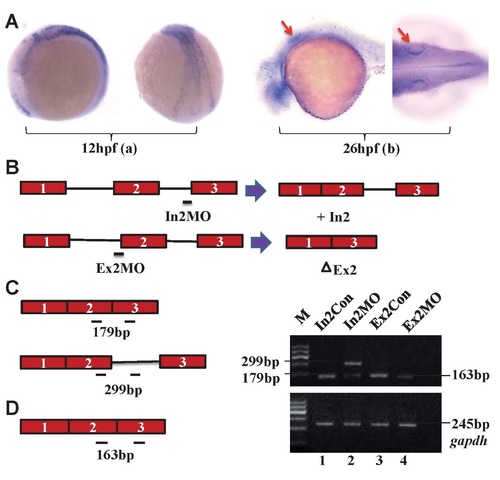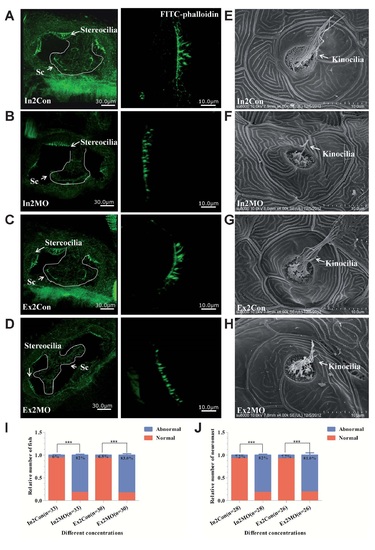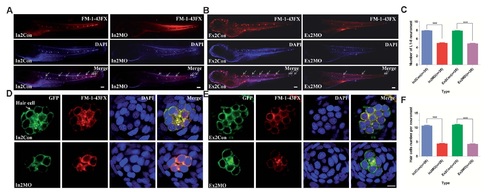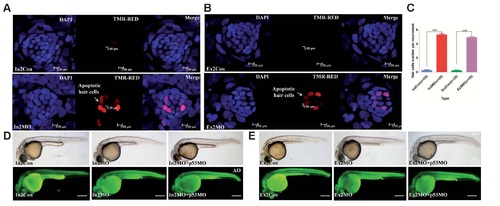- Title
-
Down-regulation of msrb3 and destruction of normal auditory system development through hair cell apoptosis in zebrafish
- Authors
- Shen, X., Liu, F., Wang, Y., Wang, H., Ma, J., Xia, W., Zhang, J., Jiang, N., Sun, S., Wang, X., Ma, D.
- Source
- Full text @ Int. J. Dev. Biol.
|
Efficiency of msrb3 morpholinos. (A) WISH at 12 hpf showed that msrb3 was widely expressed in embryos (a). At 26 hpf msrb3 was highly expressed in the inner ear of embryos (b). (B) Morpholino antisense oligonucleotides. (C) Primers designed to measure efficiency of In2MO (179 bp and 299 bp products). (D) Primers designed to measure efficiency of Ex2MO (less 163 bp product). (E) Morpholino efficiency: two msrb3 morpholinos could interfere with normal mRNA splicing (compare lane 1 to lane 2 and lane 3 to lane 4). EXPRESSION / LABELING:
|
|
Otic developmental defects in Msrb3 morphants. (A) Overall morphology of mismatched controls (In2Con, a; Ex2Con, c) and msrb3 morphants (In2MO, b; Ex2MO, d) at 60 hpf indicated otolith abnormalities. Otic vesicles were visualized at 60 hpf using DIC microscopy. Scale bars: 50 µm. Unlike mismatch control (e; k), msrb3 morphants had tiny otoliths (f, l), abnormal otolith numbers (g, m), fused otoliths (h, n), misplaced otoliths (i, o), small otoliths (j, p), shrunken inner ears, and malformed semicircular canals (f-g, l-p). (B,C) Quantitative analysis of otolith defects of In2MO and Ex2MO at different concentrations at 60 hpf. Relative number of fish with otic developmental defects. (D,E) Statistical analysis of otolith abnormalities in controls and msrb3 morphants. Error bars are s.d. ***P<0.0001. PHENOTYPE:
|
|
Cilia damage in Msrb3 morphants. (A-D) Stereocilia in zebrafish inner ear marked with FITC-labeled phalloidin (confocal microscopy). Stereocilia in msrb3 morphants (In2MO, Ex2MO) were shorter and thinner than those of mismatch controls (In2Con, Ex2Con). In addition, msrb3 morphants had malformed semicircular canals. Scale bars: 30 µm. (E-H) Kinocilia in lateral line neuromasts of morphants were damaged (not see in controls). Scale bars: 10 µm. (I) Statistical analysis of inner ear stereocilia in controls and msrb3 morphants, “n” represents fish number. Error bars are s.d. ***P<0.0001. (J) Statistical analysis of neuromast kinocilia in controls and msrb3 morphants, “n” represents neuromasts number. Error bars are s.d. ***P<0.0001. PHENOTYPE:
|
|
Down-regulation of msrb3. L1-8 neuromasts were decreased and disordered and hair cells were reduced. (A,B; D,E) Hair cells in lateral line neuromasts stained with FM-1-43FX. (A,B) In2MO and Ex2MO morphants had fewer and more disordered primary neuromasts than controls. Scale bars: 150 µm. (D,E) Msrb3 morphants had fewer hair cells per neuromast than controls. Scale bars: 5 µm. (C) Statistical analysis of the L1-8 neuromasts in mismatch controls and msrb3 morphants, “n” represents fish number. (F) Statistical analysis of hair cells per neuromast in mismatch controls and msrb3 morphants, “n” represents neuromasts number. Error bars are s.d. ***P<0.0001. |
|
Msrb3 morphant apoptotic hair cells. (A,B) TUNEL assay data. In 3 dpf larvae, msrb3 morphants had more hair cell apoptosis than mismatch controls. Scale bars, 5 µm. (C) Statistical analysis of apoptotic hair cells per neuromast in controls and msrb3 morphants, “n” represents neuromasts number. Error bars are s.d. ***P<0.0001. (D,E) Zebrafish embryos injected with msrb3 morpholinos (In2MO, Ex2MO) or co-injected with msrb3 morpholinos and p53MO-AO staining to detect whole larval apoptosis signal at 24 hpf. There was no difference between msrb3 morphants and p53MO co-injected larvae. The p53 off-target effect was ruled out. Scale bars, 200 µm. PHENOTYPE:
|
|
Msrb3 morphants are profoundly deaf. (A,C) Examples of C-shaped startle responses of different larval types after sound stimuli (500 Hz; 10 ms). The escape response of control larvae was initiated 5-13 ms after the sound stimulation. Abnormal swimming behavior of msrb3 morphants indicated a defective balance system. Some morphants had no response to voice stimulation. After co-injection with human MSRB3A mRNA (hM3A), In2MO and Ex2MO zebrafish regained some hearing. (B,D) Average C-startle response probability. For each group, 30 larvae were tested. *** P<0.0001. PHENOTYPE:
|






